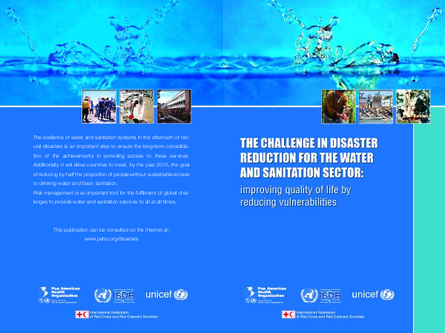
The reduction of vulnerabilities entails multi-disciplinary work in a network with other actors in risk management, such as public ministries (in particular those responsible for public works and utilities, land planning and management, health, education, and finance), disaster management agencies, NGOs, the private sector, and the academic sector (universities, professional associations, research centers) fostering the development and exchange of knowledge in matters of protecting water and sanitation systems against natural hazards.
On the other hand, the resistance of systems to natural disasters is an important step toward ensuring that the achievements made in increased access to water and sanitation services are strengthened in the long term, thereby realizing the goal of reducing by half, by the year 2015, the percentage of people that lack sustainable access to safe drinking water and basic sanitation. In this sense, the local activities of risk management position themselves as a tool for realizing the global challenges of providing water and sanitation services for all and at all times.
In January 2005 in Kobe, Japan, 168 governments committed to act to reduce disaster risk, and adopted a 10-year plan known as the Hyogo Framework for Action, with the objective of reducing vulnerability to natural hazards. The inclusion of criteria of vulnerability reduction to the impact of natural hazards in the water and sanitation sector is a priority activity for advancing the objectives of the global plan. Furthermore, water and sanitation systems warrant consideration as “critical” infrastructure, and as such are a priority for the efforts of disaster risk reduction, as are schools and hospitals. The loss of human life and economic and environmental losses as a result of disasters in 2005 serve to strengthen the belief that disaster reduction should be an integral part of sustainable development, and a critical factor for reaching the Millennium Goals. The water and sanitation sector must not be overlooked when addressing this challenge.
Resource collections
- UN Habitat - Urban Response Collection
- Urban Response - Urban Crisis Preparedness and Risk Reduction
- Urban Response Collection - Community Engagement and Social Cohesion
- Urban Response Collection - Economic Recovery
- Urban Response Collection - Environment and Climate Change
- Urban Response Collection - Housing, Land and Property
- Urban Response Collection - Urban Crisis Response, Recovery and Reconstruction
- Urban Response Collection - Urban Resilience
